Analysis of Procurement Methods and Public-Private Partnerships
VerifiedAdded on 2023/06/03
|6
|811
|176
Report
AI Summary
This report provides an overview of different procurement methods, with a detailed analysis of Public-Private Partnerships (PPP). It examines the PF2 model, where the government acts as a minority equity co-investor to enhance partnership and transparency, and the Non-Profit Distributing (NPD) model, an alternative funding option that provides a fixed rate of return to the private sector and greater public sector regulation. The report highlights the application of PPP in Australian public infrastructure projects, including the Capital Contribution model, and discusses key considerations such as risk transfer and operational demands. Referencing key sources such as KPMG and other research papers, the report concludes by emphasizing the smaller scale of social infrastructure PPP projects and the increased risk acceptance by the private sector in operational stages.
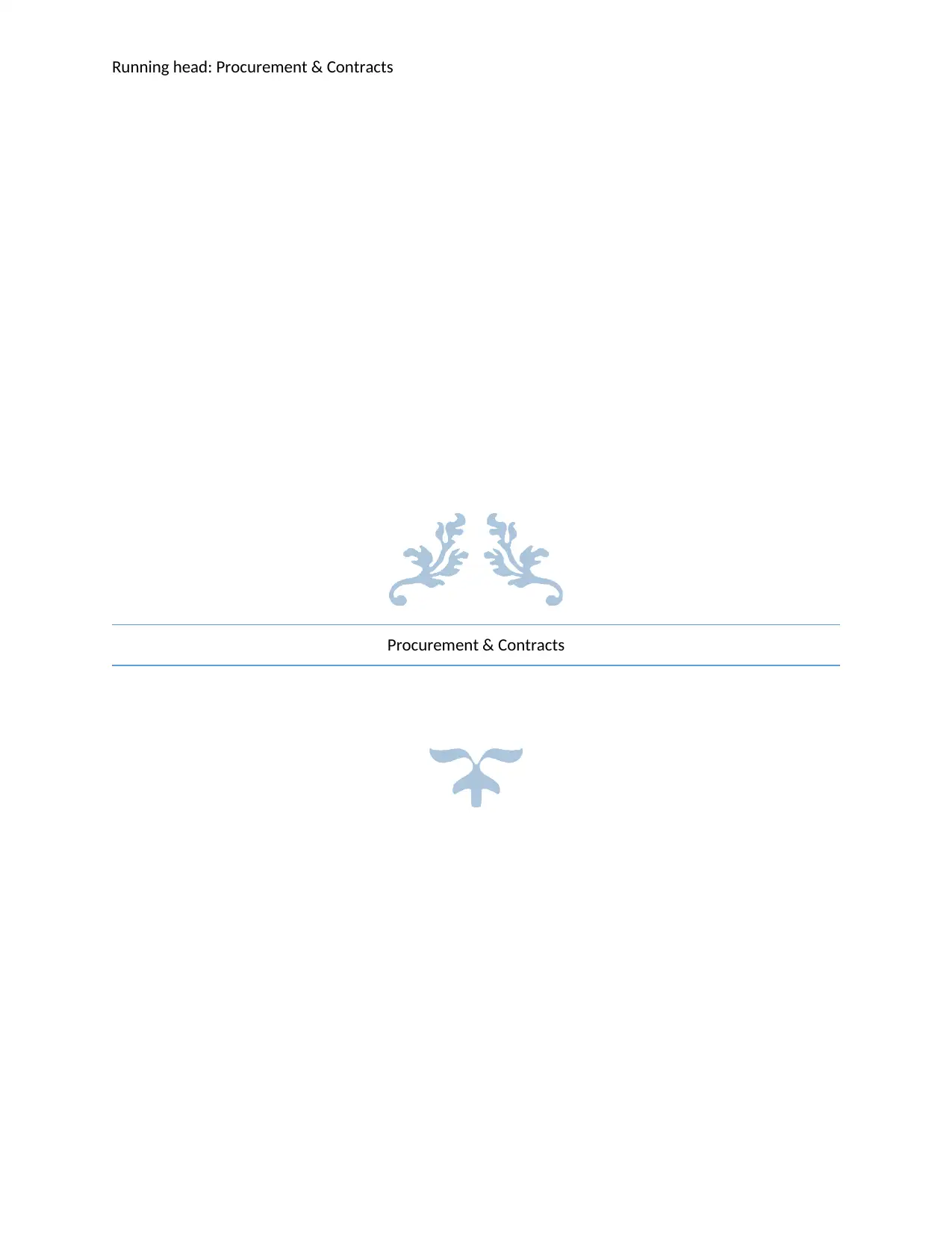
Running head: Procurement & Contracts
Procurement & Contracts
Procurement & Contracts
Paraphrase This Document
Need a fresh take? Get an instant paraphrase of this document with our AI Paraphraser
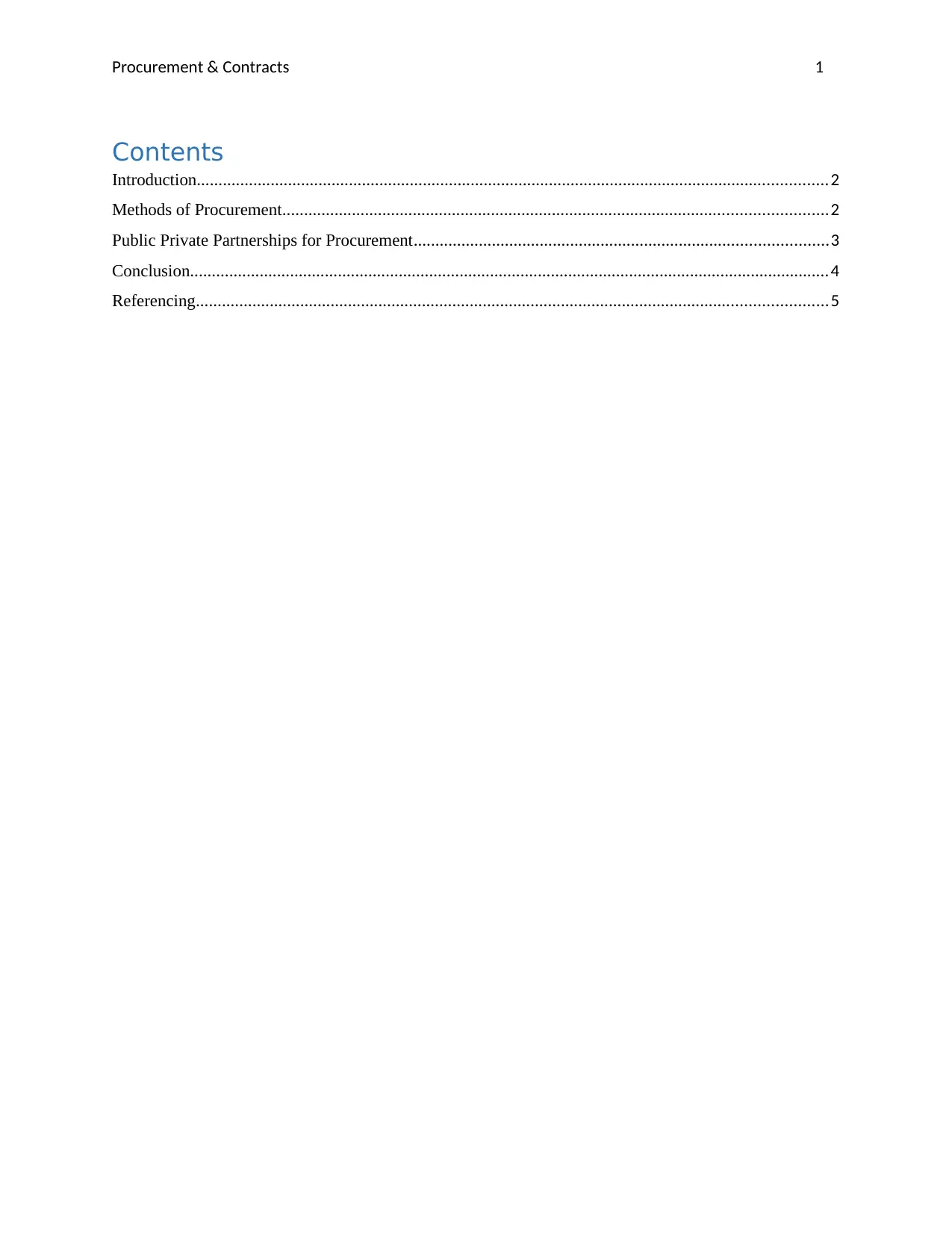
Procurement & Contracts 1
Contents
Introduction.................................................................................................................................................2
Methods of Procurement.............................................................................................................................2
Public Private Partnerships for Procurement...............................................................................................3
Conclusion...................................................................................................................................................4
Referencing.................................................................................................................................................5
Contents
Introduction.................................................................................................................................................2
Methods of Procurement.............................................................................................................................2
Public Private Partnerships for Procurement...............................................................................................3
Conclusion...................................................................................................................................................4
Referencing.................................................................................................................................................5
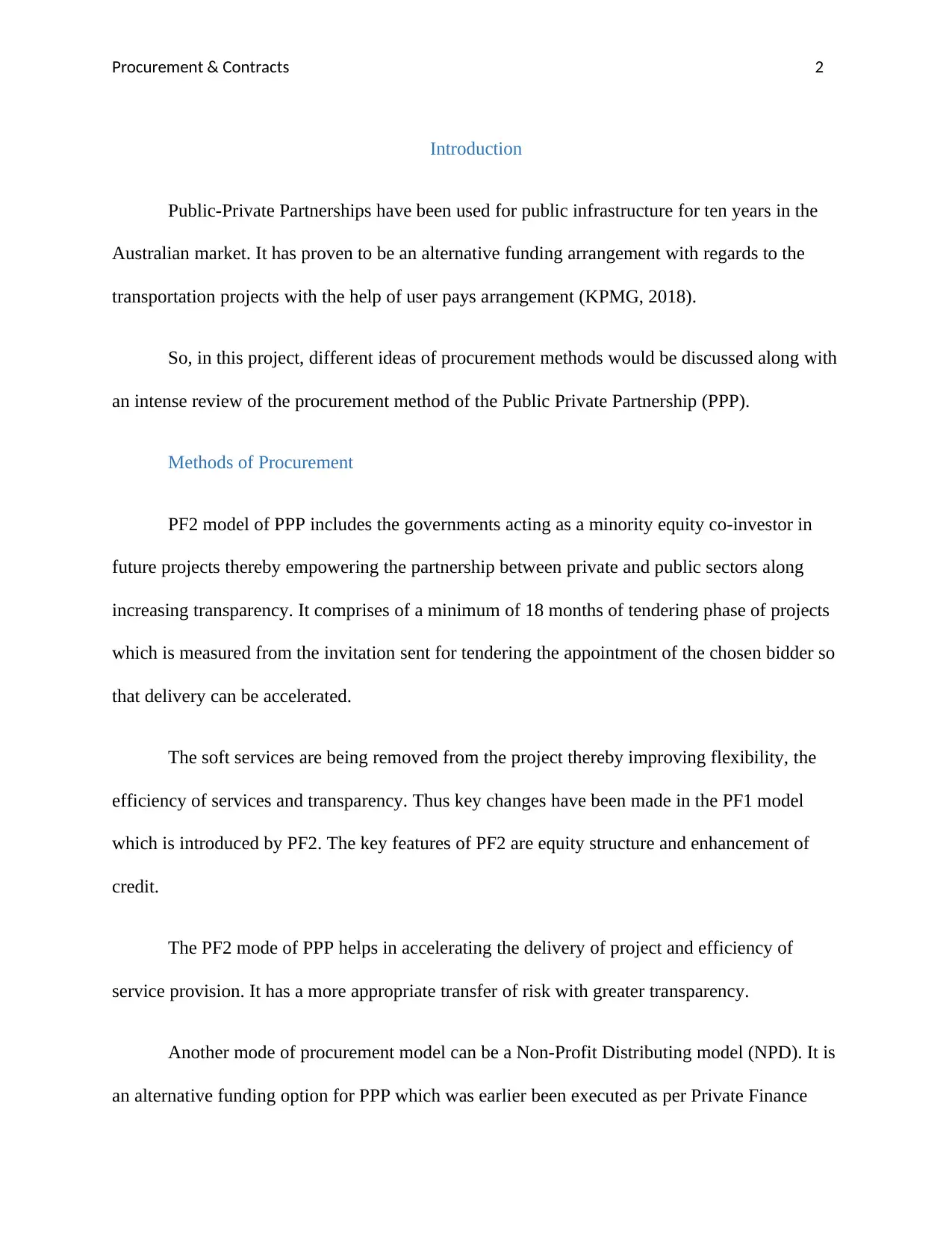
Procurement & Contracts 2
Introduction
Public-Private Partnerships have been used for public infrastructure for ten years in the
Australian market. It has proven to be an alternative funding arrangement with regards to the
transportation projects with the help of user pays arrangement (KPMG, 2018).
So, in this project, different ideas of procurement methods would be discussed along with
an intense review of the procurement method of the Public Private Partnership (PPP).
Methods of Procurement
PF2 model of PPP includes the governments acting as a minority equity co-investor in
future projects thereby empowering the partnership between private and public sectors along
increasing transparency. It comprises of a minimum of 18 months of tendering phase of projects
which is measured from the invitation sent for tendering the appointment of the chosen bidder so
that delivery can be accelerated.
The soft services are being removed from the project thereby improving flexibility, the
efficiency of services and transparency. Thus key changes have been made in the PF1 model
which is introduced by PF2. The key features of PF2 are equity structure and enhancement of
credit.
The PF2 mode of PPP helps in accelerating the delivery of project and efficiency of
service provision. It has a more appropriate transfer of risk with greater transparency.
Another mode of procurement model can be a Non-Profit Distributing model (NPD). It is
an alternative funding option for PPP which was earlier been executed as per Private Finance
Introduction
Public-Private Partnerships have been used for public infrastructure for ten years in the
Australian market. It has proven to be an alternative funding arrangement with regards to the
transportation projects with the help of user pays arrangement (KPMG, 2018).
So, in this project, different ideas of procurement methods would be discussed along with
an intense review of the procurement method of the Public Private Partnership (PPP).
Methods of Procurement
PF2 model of PPP includes the governments acting as a minority equity co-investor in
future projects thereby empowering the partnership between private and public sectors along
increasing transparency. It comprises of a minimum of 18 months of tendering phase of projects
which is measured from the invitation sent for tendering the appointment of the chosen bidder so
that delivery can be accelerated.
The soft services are being removed from the project thereby improving flexibility, the
efficiency of services and transparency. Thus key changes have been made in the PF1 model
which is introduced by PF2. The key features of PF2 are equity structure and enhancement of
credit.
The PF2 mode of PPP helps in accelerating the delivery of project and efficiency of
service provision. It has a more appropriate transfer of risk with greater transparency.
Another mode of procurement model can be a Non-Profit Distributing model (NPD). It is
an alternative funding option for PPP which was earlier been executed as per Private Finance
⊘ This is a preview!⊘
Do you want full access?
Subscribe today to unlock all pages.

Trusted by 1+ million students worldwide
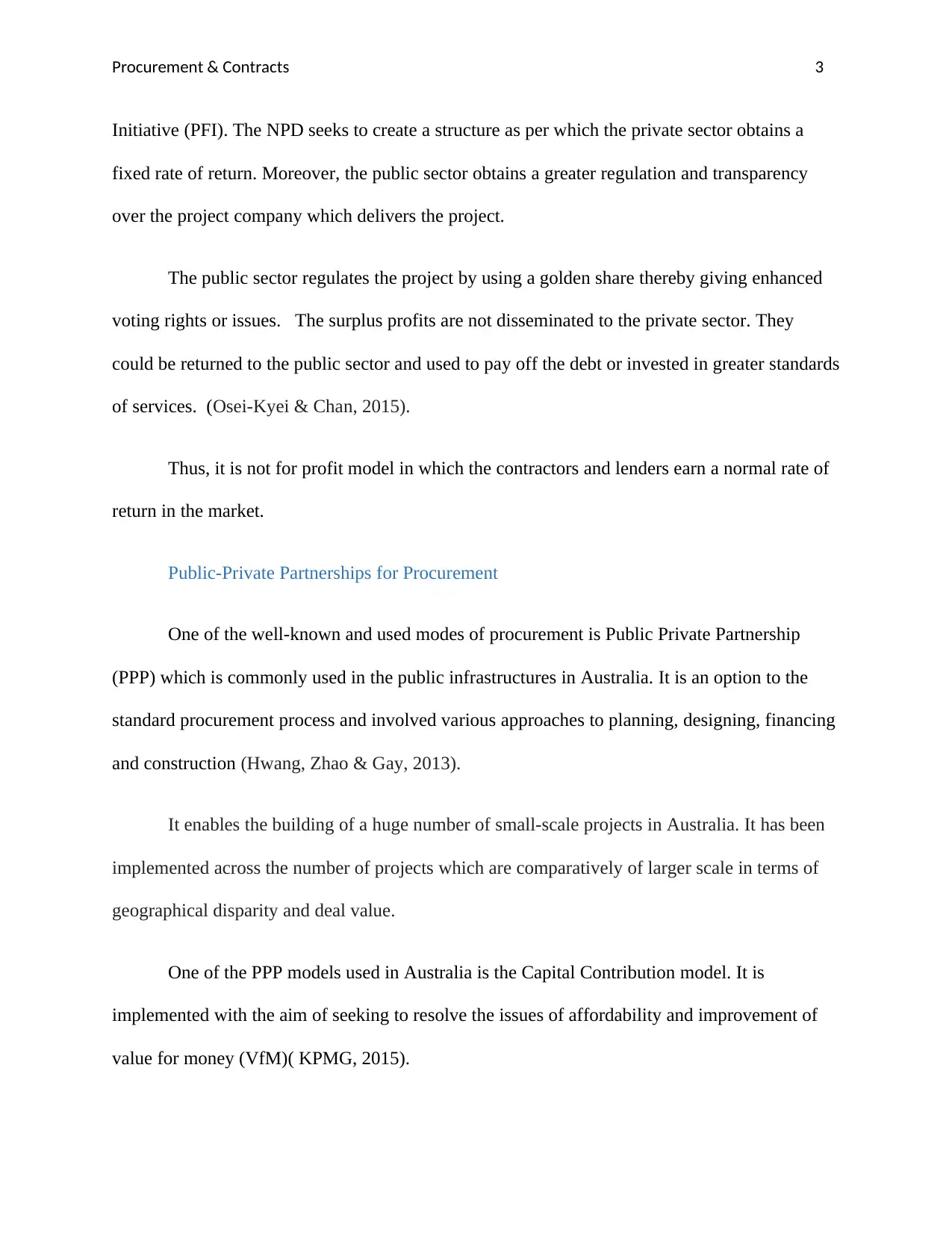
Procurement & Contracts 3
Initiative (PFI). The NPD seeks to create a structure as per which the private sector obtains a
fixed rate of return. Moreover, the public sector obtains a greater regulation and transparency
over the project company which delivers the project.
The public sector regulates the project by using a golden share thereby giving enhanced
voting rights or issues. The surplus profits are not disseminated to the private sector. They
could be returned to the public sector and used to pay off the debt or invested in greater standards
of services. (Osei-Kyei & Chan, 2015).
Thus, it is not for profit model in which the contractors and lenders earn a normal rate of
return in the market.
Public-Private Partnerships for Procurement
One of the well-known and used modes of procurement is Public Private Partnership
(PPP) which is commonly used in the public infrastructures in Australia. It is an option to the
standard procurement process and involved various approaches to planning, designing, financing
and construction (Hwang, Zhao & Gay, 2013).
It enables the building of a huge number of small-scale projects in Australia. It has been
implemented across the number of projects which are comparatively of larger scale in terms of
geographical disparity and deal value.
One of the PPP models used in Australia is the Capital Contribution model. It is
implemented with the aim of seeking to resolve the issues of affordability and improvement of
value for money (VfM)( KPMG, 2015).
Initiative (PFI). The NPD seeks to create a structure as per which the private sector obtains a
fixed rate of return. Moreover, the public sector obtains a greater regulation and transparency
over the project company which delivers the project.
The public sector regulates the project by using a golden share thereby giving enhanced
voting rights or issues. The surplus profits are not disseminated to the private sector. They
could be returned to the public sector and used to pay off the debt or invested in greater standards
of services. (Osei-Kyei & Chan, 2015).
Thus, it is not for profit model in which the contractors and lenders earn a normal rate of
return in the market.
Public-Private Partnerships for Procurement
One of the well-known and used modes of procurement is Public Private Partnership
(PPP) which is commonly used in the public infrastructures in Australia. It is an option to the
standard procurement process and involved various approaches to planning, designing, financing
and construction (Hwang, Zhao & Gay, 2013).
It enables the building of a huge number of small-scale projects in Australia. It has been
implemented across the number of projects which are comparatively of larger scale in terms of
geographical disparity and deal value.
One of the PPP models used in Australia is the Capital Contribution model. It is
implemented with the aim of seeking to resolve the issues of affordability and improvement of
value for money (VfM)( KPMG, 2015).
Paraphrase This Document
Need a fresh take? Get an instant paraphrase of this document with our AI Paraphraser

Procurement & Contracts 4
Conclusion
Hence to conclude it can be said that the PPP projects pertaining to social infrastructure
are characterized by smaller in scale as compared to the economic infrastructure projects in
Australia. They consider a range of issues like the quantum and timings of the debt payments.
The bidders of the private sector are often confronted with the situation in which the monetary
rewards are lower with more complicated operational demands.
The private sector would thus accept the increased transfer of risk from the public sector
which would largely be involved in the operational stages of social infrastructure PPPs.
Conclusion
Hence to conclude it can be said that the PPP projects pertaining to social infrastructure
are characterized by smaller in scale as compared to the economic infrastructure projects in
Australia. They consider a range of issues like the quantum and timings of the debt payments.
The bidders of the private sector are often confronted with the situation in which the monetary
rewards are lower with more complicated operational demands.
The private sector would thus accept the increased transfer of risk from the public sector
which would largely be involved in the operational stages of social infrastructure PPPs.
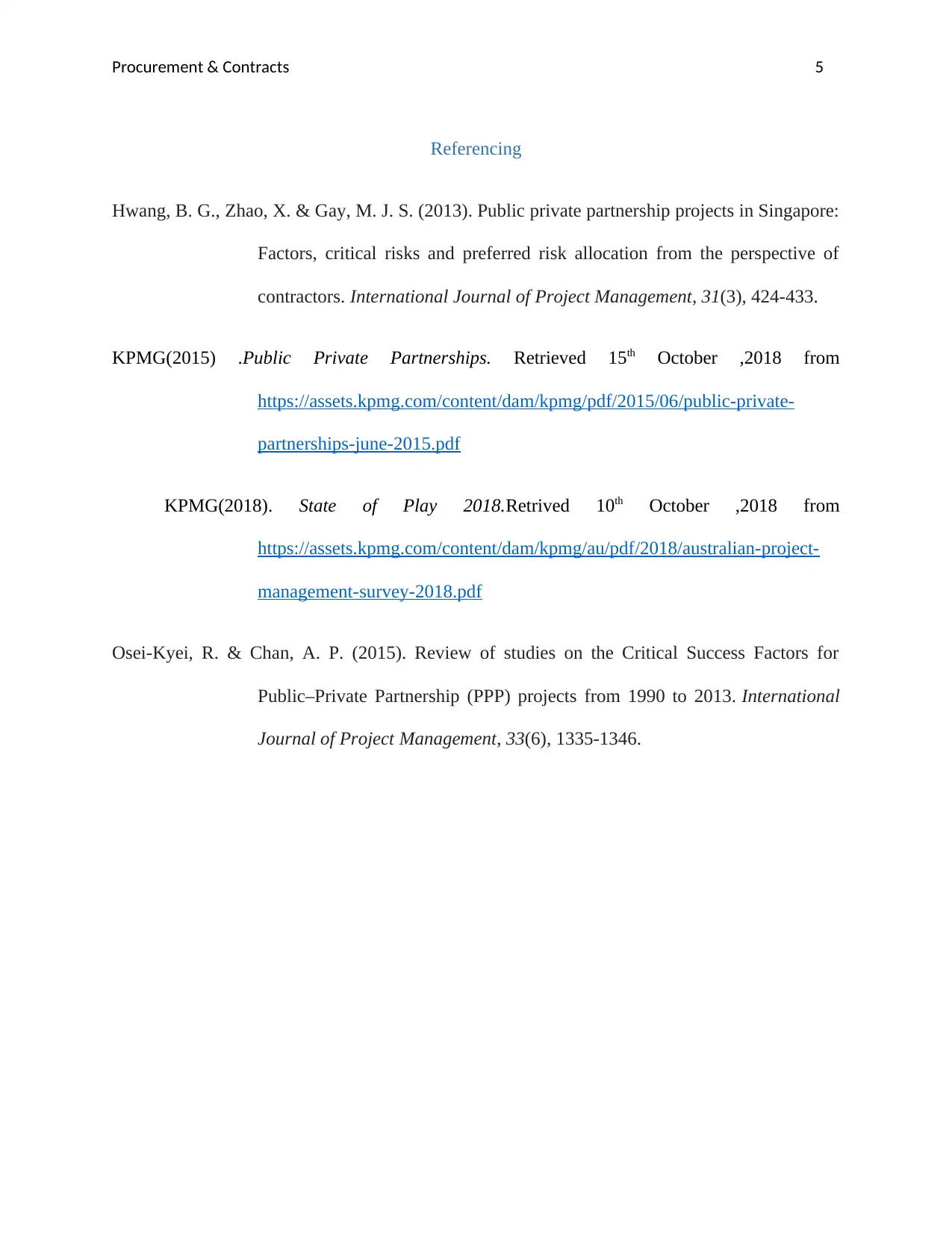
Procurement & Contracts 5
Referencing
Hwang, B. G., Zhao, X. & Gay, M. J. S. (2013). Public private partnership projects in Singapore:
Factors, critical risks and preferred risk allocation from the perspective of
contractors. International Journal of Project Management, 31(3), 424-433.
KPMG(2015) .Public Private Partnerships. Retrieved 15th October ,2018 from
https://assets.kpmg.com/content/dam/kpmg/pdf/2015/06/public-private-
partnerships-june-2015.pdf
KPMG(2018). State of Play 2018.Retrived 10th October ,2018 from
https://assets.kpmg.com/content/dam/kpmg/au/pdf/2018/australian-project-
management-survey-2018.pdf
Osei-Kyei, R. & Chan, A. P. (2015). Review of studies on the Critical Success Factors for
Public–Private Partnership (PPP) projects from 1990 to 2013. International
Journal of Project Management, 33(6), 1335-1346.
Referencing
Hwang, B. G., Zhao, X. & Gay, M. J. S. (2013). Public private partnership projects in Singapore:
Factors, critical risks and preferred risk allocation from the perspective of
contractors. International Journal of Project Management, 31(3), 424-433.
KPMG(2015) .Public Private Partnerships. Retrieved 15th October ,2018 from
https://assets.kpmg.com/content/dam/kpmg/pdf/2015/06/public-private-
partnerships-june-2015.pdf
KPMG(2018). State of Play 2018.Retrived 10th October ,2018 from
https://assets.kpmg.com/content/dam/kpmg/au/pdf/2018/australian-project-
management-survey-2018.pdf
Osei-Kyei, R. & Chan, A. P. (2015). Review of studies on the Critical Success Factors for
Public–Private Partnership (PPP) projects from 1990 to 2013. International
Journal of Project Management, 33(6), 1335-1346.
⊘ This is a preview!⊘
Do you want full access?
Subscribe today to unlock all pages.

Trusted by 1+ million students worldwide
1 out of 6
Related Documents
Your All-in-One AI-Powered Toolkit for Academic Success.
+13062052269
info@desklib.com
Available 24*7 on WhatsApp / Email
![[object Object]](/_next/static/media/star-bottom.7253800d.svg)
Unlock your academic potential
Copyright © 2020–2025 A2Z Services. All Rights Reserved. Developed and managed by ZUCOL.




